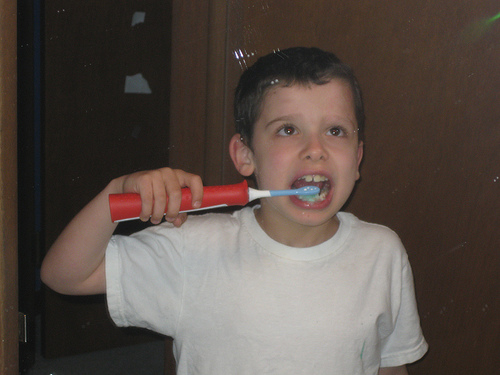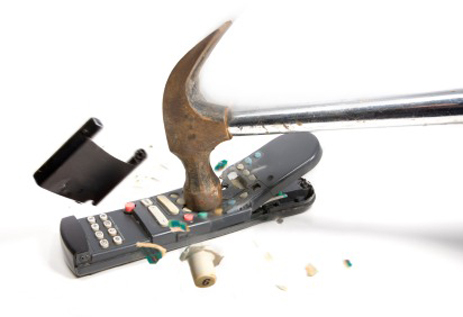Send your question to Umbra!
Q. Dear Umbra,
My Sonicare toothbrush is broken, and I’m pretty sure it’s just one small part that needs replacing. In the interest of defying planned obsolescence and also saving money, how do you suggest I go about getting small appliances like this fixed? Other examples include digital cameras, cell phones, etc.
Jennifer M.
Seattle, WA
 But what happens when it breaks?Photo: Rachel Singer GordonA. Dearest Jennifer,
But what happens when it breaks?Photo: Rachel Singer GordonA. Dearest Jennifer,
A broken toothbrush is never good for one’s smile. I want to give you two gold crowns for effort — one for attempting to take good care of your teeth and the other for your interest in fixing your electric toothbrush. ‘Tis better to repair than toss with your floss.
We’ll get to resources to help you fix what’s broken. First, let’s look at the big picture.
You mentioned planned obsolescence, a term worth talking about. If you, like me, have found the gadgets in your life such as phones, cameras, printers, etc. quickly becoming obsolete, whether they are broken or simply outdated, that’s planned obsolescence rearing its ugly head.
The Story of Electronics, the latest short film from Annie Leonard (she of The Story of Stuff), outlines this problem. (You can see the trailer here. The full video debuts Nov. 9!) The Story of Electronics is a great overview of how our gadgets are “designed for the dump,” leading us to throw them away and buy “new and improved” thingamabobs.
The problem encompasses the manufacturing, shipping, use, and disposal of many of our gizmos. It’s an environmental concern and a human health issue too. “Many of our gadgets are made from more than 1,000 different materials, shipped from around the world to assembly plants,” says Leonard. According to the EPA, more than 3 million tons of e-waste was generated in 2007 in the U.S. alone. Of that waste, only 13.6 percent was recycled. The other 86.4 percent ended up in landfills or incinerators, allowing hazardous chemicals to leach into groundwater and emit dioxins into the air. Lead, cadmium, mercury, PVC, and flame retardants make up some of the toxic soup leaking from your old cell phones and such.
Organizations like the Electronics TakeBack Coalition, which promotes green design and responsible recycling in the electronics industry, are working to force manufacturing companies to make better, less toxic, longer-lasting products. “Making companies deal with their e-waste is called Extended Producer Responsibility, or Product Takeback,” notes Leonard in The Story of Electronics. “Already, takeback laws are popping up all over Europe and Asia. In the U.S., many cities and states are passing similar laws — these need to be protected and strengthened.”
Like some people in therapy, to get to the root of the problem you have to look at where the problem first came from — in this case, the product’s proverbial parents. Which brings me back to your broken Sonicare toothbrush, Jennifer. I went to the Sonicare website. You can find warranty information, where to have your toothbrush repaired, manuals, and FAQs to help you deal with common problems yourself. Your brush apparently has a 2-year warranty. Whether your warranty has expired or not, give the company a call. It appears you can even live chat with someone in customer service. Tell them your problem and get some free help and information. By calling and not just eighty-sixing your little machine, you can make the manufacturer more accountable for its wares.
If the company doesn’t get the problem solved, here are some other handy online resources to help you in your fearless dare to repair:
- How to repair small appliances on Howstuffworks.com
- Troubleshoot repairs on small appliances
- Repairing your Sonicare on Instructables.com
Fixing your toothbrush yourself is a great way to save money. Another added bonus to fixing is it gives you a fix, or rather an endorphine rush. After the fixer’s high, you’ll likely find your relationship with said fixed thing has deepened too. And you’ll be keeping that tooth scrubber out of the landfill or incinerator. That’s sure to bring a smile to show off those pearly whites. Just make sure your toothbrush doesn’t end up on this fixers’ FAIL blog! If you do, you can always consider using a manual brush made from recycled materials…
Good luck fixing, Jennifer.
Mendily,
Umbra
Get Off Your Ass Alert:
- Host a Story of Electronics viewing party and share with your friends and family the impact that are little gadgets have. While you’re together, you can send a strong message to electronics companies, demanding that they “Make ’em Safe, Make ’em Last, and Take ’em Back.”
- The Electronics TakeBack Coalition promotes green design and responsible recycling in the electronics industry. Join them in demanding green tech products from producers and learn how to buy a better computer here.
- If you have a piece of machinery that can’t be fixed, you can find responsible recyclers of e-waste here.
- Watch this video from my visit to the Fixers’ Collective. Then host your own Fixers’ Collective gathering. Fixers’ Collective is a social experiment in improvisational fixing and mending that meets weekly in Brooklyn, N.Y. Follow in their footsteps and find a space, time, and assorted tools. Invite friends to bring their broken stuff. You’ll spend quality time together and you’ll learn something and possibly even fix some things. Try to get a super-handy master fixer type to come join the party. It’s always good to have one on hand.
- Research before you buy electronics to increase the chances you’re getting something built to last. Demand better products by buying better products. One way to get started is by checking the EPA’s Electronic Product Environmental Assessment Tool.




